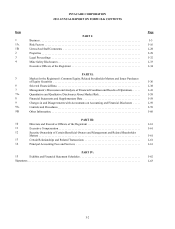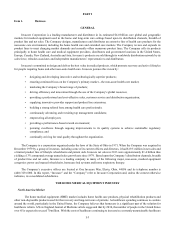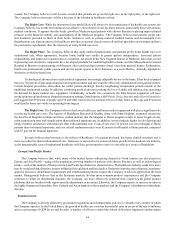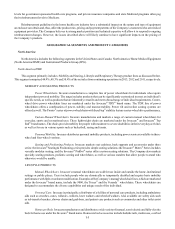Invacare 2013 Annual Report Download - page 18
Download and view the complete annual report
Please find page 18 of the 2013 Invacare annual report below. You can navigate through the pages in the report by either clicking on the pages listed below, or by using the keyword search tool below to find specific information within the annual report.I-12
Europe
The Company has eight manufacturing/assembly facilities spread throughout Europe with the capability to manufacture
patient aid, wheelchair, powered mobility, bath safety, beds and patient transport products. The European manufacturing and
logistics facilities are focused on opportunities to gain productivity improvements in cost and quality over the next few years.
GOVERNMENT REGULATION
The Company is directly affected by government regulation and reimbursement policies in virtually every country in which
it operates. Government regulations and health care policy differ from country to country, and within some countries (most notably
the U.S., European Union, Australia and Canada), from state to state or province to province. Changes in regulations and health
care policy take place frequently and can impact the size, growth potential and profitability of products sold in each market.
In the U.S., the growth of health care costs has increased at rates in excess of the rate of inflation and as a percentage of
GDP for several decades. A number of efforts to control the federal deficit have impacted reimbursement levels for government
sponsored health care programs and private insurance companies often imitate changes made in federal programs. Reimbursement
guidelines in the home health care industry have a substantial impact on the nature and type of equipment a consumer can obtain
and thus, affect the product mix, pricing and payment patterns of the Company’s customers who are the HME providers.
The Company has continued its pro-active efforts to try to influence public policy that impacts home and community-based,
non-acute health care. The Company has been very active with federal legislation and regulatory policy makers. Invacare believes
that these efforts have given the Company a competitive advantage in two ways. First, customers frequently express appreciation
for the Company’s efforts on behalf of the entire industry. Second, sometimes the Company has the ability to anticipate and plan
for changes in public policy, unlike most other HME manufacturers who must react to change after it occurs.
FDA.
The United States Food and Drug Administration (the “FDA”) regulates the manufacture and sale of medical devices. Under
such regulation, medical devices are classified as Class I, Class II or Class III devices, depending on the level of risk posed to
patients, with Class III designating the highest-risk devices. The Company’s principal products are designated as Class I or Class
II devices. In general, Class I devices must comply with labeling and record keeping requirements and are subject to other general
controls. In addition to general controls, certain Class II devices must comply with product design and manufacturing controls in
compliance with regulations established by the FDA. Domestic and foreign manufacturers of medical devices distributed
commercially in the U.S. are subject to periodic inspections by the FDA. Furthermore, state, local and foreign governments have
adopted regulations relating to the design, manufacture and marketing of health care products.
Consent Decree.
In December 2012, the Company reached an agreement with the FDA on the terms of a consent decree of injunction with
respect to the Company's corporate facility and its Taylor Street wheelchair manufacturing facility in Elyria, Ohio. The consent
decree, which was filed as an exhibit to the Company's Form 8-K filed on December 20, 2012, became effective December 21,
2012. The injunction limits the Company's manufacture and distribution of power and manual wheelchairs, wheelchair components
and wheelchair sub-assemblies at or from its Taylor Street manufacturing facility. The decree also temporarily limited design
activities related to wheelchairs and power beds that took place at the impacted Elyria, Ohio facilities. The Company is entitled
to continue to produce from the Taylor Street manufacturing facility certain medically necessary wheelchairs provided that
documentation and record-keeping requirements are followed, as well as ongoing replacement, service and repair of products
already in use, under terms delineated in the consent decree. In addition, the Company was able to fulfill purchase orders and
quotes that were in the Company's order fulfillment system prior to the effective date of the decree. Under the terms of the consent
decree, in order to resume full operations at the impacted facilities, the Company must successfully complete a third-party expert
certification audit and receive written notification from the FDA. The expert certification audit will be followed by an FDA
inspection of the Company's compliance with the FDA's Quality System Regulation (QSR) governing manufacturing of medical
devices. The certification audit is comprised of three distinct reports, which include:
• First, the third-party expert inspected the qualification and validation procedures and documentation for equipment and
processes at the Taylor Street manufacturing facility. The first certification audit was successfully completed during
2013. The FDA notified the Company on May 13, 2013 that it had accepted the first certification report. Following
receipt of that notification, Invacare was permitted to resume manufacturing at the Taylor Street facility and distribution
of parts, components and accessories, and sub-assemblies used in the service and repair of products manufactured at
Invacare facilities other than Taylor Street.
























